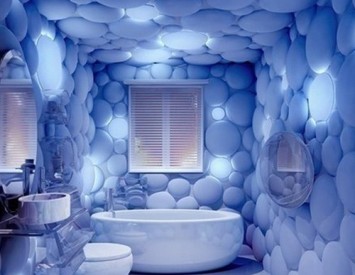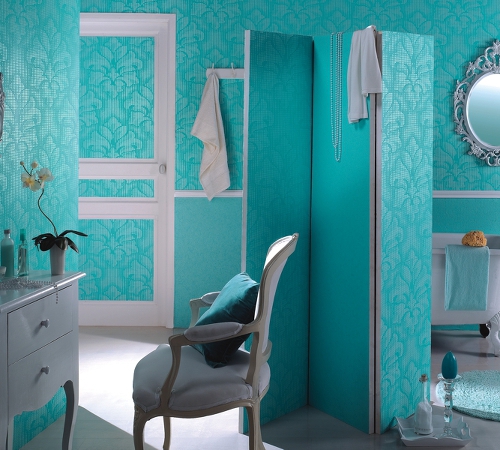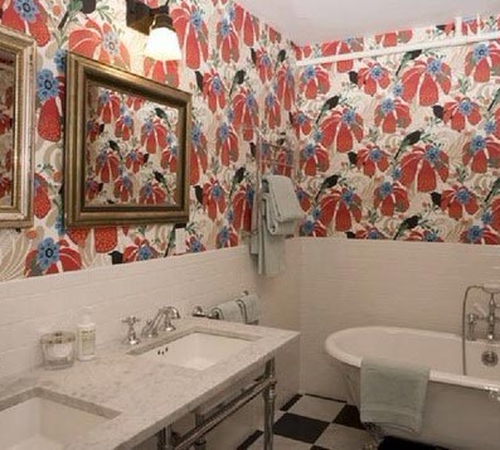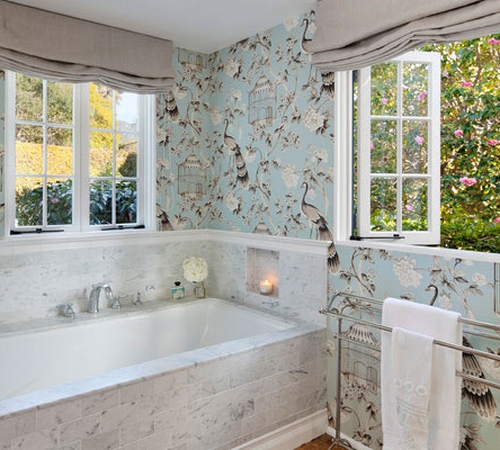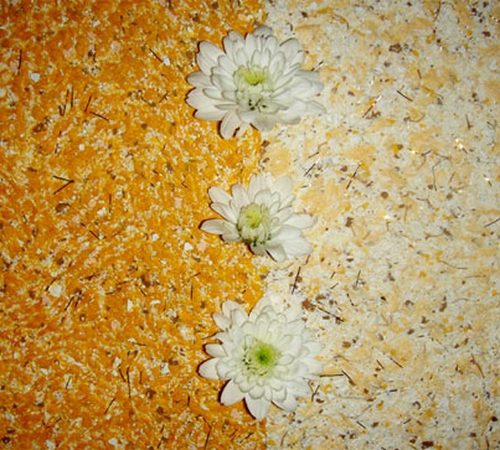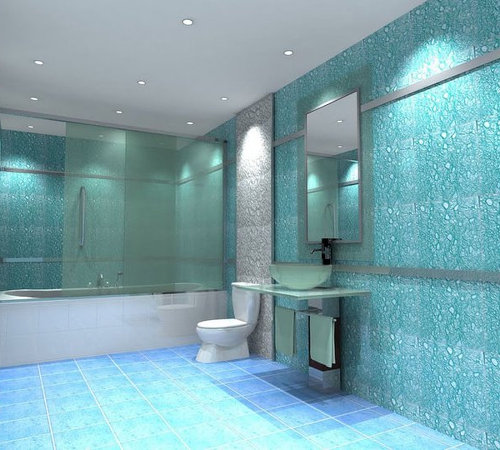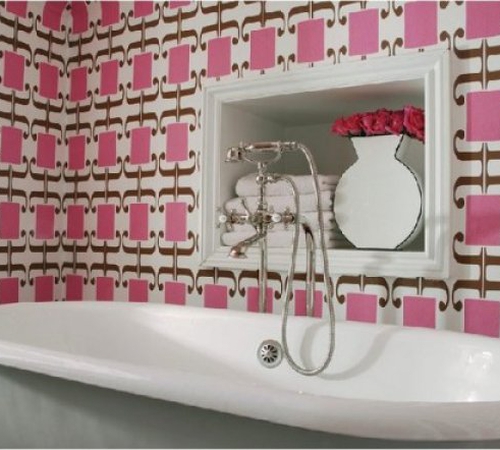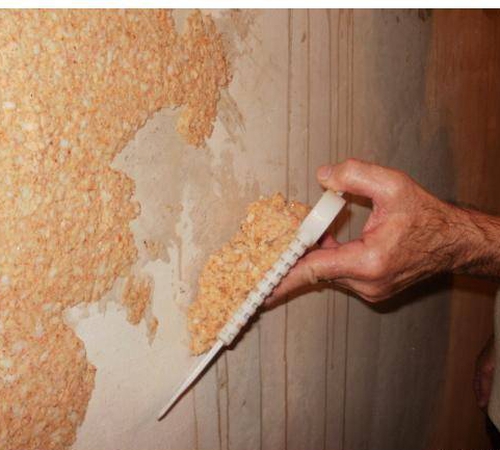About ten years ago, the question of how to finish the walls of the bathroom did not stand. But today, taking into account the advanced technological capabilities and the abundance of various building materials, it becomes relevant. The standard tile is already starting to slowly go out of fashion, the plastic looks like the virgin, the lining is far from always appropriate, and wallpaper for the bathroom is just what you need.
Content
Varieties of wallpaper for bathroom
The popularity of such finishing material as wallpaper is caused by a relatively inexpensive price, ease of installation and a rich palette of various options. These factors prompted the manufacturers to create a completely new product that would significantly expand the possibilities of using this product. The idea in the form of several options for wallpaper was embodied:
- washing,
- moisture -resistant vinylovs,
- self -adhesive,
- liquid.
Each of the options has both its advantages and disadvantages, on which we dwell in more detail.
Washing bathroom wallpaper
This product appeared at the beginning of the two thousand years and at first did not differ in the declared characteristics. Nevertheless, today washing wallpaper is a fairly high -quality wear -resistant material.
Its main feature is a special impregnation that creates a microfill on the surface. repulsive moisture. This allows you to wash the wallpaper with a wet rag and, even, pour water on them without any change in texture.
Most often they are used in children's rooms and in the kitchen, where wall pollution is in the order of things. Although the material has good enough waterproofing properties, it is not suitable for the bathroom.
This is due to the features of the operational regime of the premises. The bath is always high humidity, in itself, it is not terrible for wallpaper, but the guy has extremely negatively affects them. The couples are able to penetrate the protective film and accumulate in the paper texture of the wallpaper. As a result, they will begin to drop from the walls and break. In addition, even slight damage to the protective film makes the entire strip unusable.
Even high -quality ventilation of the room and an extremely careful attitude towards the walls I do not guarantee one hundred percent protection.
Sometimes, after the repair, several rolls of wallpaper remain, which it is a pity to throw out, and there is nowhere to children. In order not to throw the material, it can be used for the bathroom, but the entire surface will need to be treated with transparent waterproof varnish. The disadvantage is the appearance and extremely weak wall ventilation.
Bathroom vinyl wallpaper
Washing wallpaper should have been replaced by vinyl. But their cost is higher, so they did not compete with each other. Vinyl -based wallpapers already have certain moisture -proof properties that emerge from the properties of the material.
But this is not enough to withstand hard loads in the bathroom. They are impregnated and covered with special additives that reduce the destructive effect of water and steam to nothing. Such wallpapers:
- wear -resistor,
- durable,
- do not grin from washing
- do not mold.
We must not forget that vinyl wallpapers, like washable, are made of paper. It is very important to walk in the fit places, perfectly fix the upper and lower edge. The slightest gap will lead to the fact that condensate will begin to form in it. Under the weight and exposure of moisture, the glue will gradually move away from the wall, as a result the sheet will fall off. It will not be possible to re -glue it again, since moisture on the reverse side will most likely cause mold, therefore, you will have to do chemical treatments or re -plaster part of the wall.
Self -adhesive wallpaper moisture -resistant for the bathroom
Unlike the above, this option does not contain paper. It is completely made of PVC. Given that plastic reacts to water completely indifferently, this option is one of the most reliable.
On the other hand, they are far from always sold in construction stores and are represented by a rather scarce assortment. This circumstance forces to contact specialized private firms that make wallpaper with the desired pattern and the corresponding size.
Another drawback is the difficulty of dismantling. They are removed using a construction hair dryer, but this must be done extremely carefully, otherwise the material will melt and stick to the wall, which will then be difficult enough to clean.
The durability and reliability of the material more than compensate for all its minor disadvantages.
Liquid wallpaper in the bathroom
Are the most modern and popular material. Initially, they are dry powder, which consists of a wallpaper base and special protective additives, providing moisture resistance to the material and protection from fungus, mold and bacteria.
Liquid wallpaper is diluted with water and then applied to the wall like plaster. This is one of the main advantages of the material. Possessing high adhesion, he makes preliminary plastering walls optional. Due to the soft binder, the wallpaper easily fill any cracks and bumps, as a result, a perfectly smooth surface is obtained.
Some varieties of this material imitate a natural stone, it is better to use them in houses of the old building, where it is quite difficult to find a right angle and make beacons quite difficult. The textured application technology will visually correct this drawback.
These are wallpapers for the bathroom, the price of which is justified by quality. A pleasant, soft texture to the touch, an unlimited service life, a richest variety of execution options and the ability to realize any design solutions.
The only drawback is the lack of good distributors in small cities, but this phenomenon is temporary. To understand what this material is, see the bathroom wallpaper:
How to choose safe wallpaper
To buy a bathroom wallpaper that will be safe for health, you need to carefully read the composition. Most protective additives are made of products of the oil chemical industry. From the point of view of the molecular composition, they include volatile compounds that evaporate quite easily into the environment. Among them, they highlight:
- safe,
- permissible,
- poisonous.
Safe impregnations do not have any smell, this is the main criterion according to which environmentally friendly wallpaper from the product of the chemical industry is distinguished.
The permissible impregnations highlight the smell, but it is practically not noticeable. With good ventilation of the premises, a pair of chemicals will disappear faster than they will have time to harm the body.
Unbearable impregnations are distinguished by a sharp, unpleasant odor, similar to acetone, varnish or gasoline. The allocated vapors are heavier than air, so they settle in the room and affect human health.
The first symptom is headaches, then pain in the liver begins, problems with the circulatory system and neurosis. A long stay in the room leads to the appearance of hallucinations.
The use of such harmful components is due to the fact that their cost is not high and allows you to strongly save in production.
The smell cannot be forgotten to indicate on the label or somehow disguise, this is the most sure sign of product quality.
If we consider the issue of chemistry, then any acetates and benzene are considered extremely dangerous and are not compatible with household everyday use.
Playing technology
How long the wallpaper will last for a long time depends primarily on the quality of gluing. Consider this process as in detail as possible:
- dilute wallpaper glue (under the corresponding type of wallpaper) in the proportions indicated on the pack,
- stir well and give the glue to stand for 20-30 minutes,
- during this time, prepare a strip of wallpaper,
- it is necessary to cut it with a margin of at least 4 cm from above and below,
- make the back of the adhesive strip and fold in half, leave in this position for 5-10 minutes,
- while the wallpaper is impregnated, grease the wall with glue,
- straighten and stick the strip (from the ceiling to the floor).
It is better to do all the work together, this will not only save time, but also ensure the quality of gluing.
An important point is the seams. They are rolled with a special plastic roller, while, after the first rolling of the edge, it is necessary to bend, smear again with glue and finally fixed.
The wallpaper is leveled exclusively by a special plastic spatula, and in the event that the width of the strip of more than one meter is a roller.
It is better to close the fit of the wallpaper to the ceiling with moldings, and to the floor with skirting boards.
This technique is applicable only for paper wallpaper, we will consider how to work with other types.
Self -adhesive wallpapers consist of a drawing and a back with a protective film. In order to fix the strip on the wall, it is necessary to remove the protective film and gently stick the wallpaper. To improve adhesion, the surface of the wall and the back must be moistened with water, for these purposes a manual spray gun is used.
The strip is glued for 5-7 minutes, so all the bubbles of folds and irregularities need to be removed as quickly as possible. This is done with a plastic spatula. In addition, gluing is allowed only on a perfectly smooth surface, there should be no cracks or cracks on the wall.
As for the liquid wallpaper, the installation technology is very similar to plaster. The only difference is that the solution should stand at least 12 hours, it must be used within two weeks. In a divorced form, the wallpaper is stored in a cool, non -ventilated room without access to direct sunlight.
All the same options that are characteristic of ordinary plaster are allowed:
- texture,
- fur coat,
- the surface,
- pattern,
- christmas trees.
The method of application is exactly the same. Liquid wallpaper dry after about 24 hours. After that, they are completely ready for use.
All types of wallpaper are characterized by one common feature, glue reacts extremely poorly to drafts. Therefore, when performing work, the movement of air must be limited as much as possible, to open windows or entrance doors is strictly not allowed.
Recommended firms
A lot of firms are engaged in the production of moisture -resistant wallpaper. This does not need large industrial capacities or the presence of a team of highly qualified specialists. By virtue of this, it is advisable to buy products of only trusted brands, which have proven themselves not only in Russia, but also around the world. Among them:
- Senideco,
- Silkcoat,
- COTEX,
- Stenol,
- Bioplast.
Senideco is the largest concern in Europe that specializes in wallpaper production. The French company, this affects both the variety of options and their quality. Many years of experience and its own design bureau allow the company to make a unique and reliable product.
In second place in popularity, also the French company COTEX. The main and main direction is self -adhesive and murals. Nevertheless, there are moisture -resistant vinyls and liquid wallpaper in the assortment. Bow the leader only of the palette of flowers.
Silkcoat is a brand from Turkey. With a fairly high quality of products, it is much cheaper than that of Europeans. Products are represented only by the most fashionable and modern colors of colors, but you should not expect a wide variety.
Stenol is a leading Russian wallpaper manufacturer. She appeared on the market recently, but already managed to get fans. This is primarily due to the revolutionary production technology, which allows you to use only natural materials. All products are absolutely safe for health.
Another domestic manufacturer is Bioplast. It is engaged exclusively in the production of liquid wallpaper. It appeared on the market more than five years ago. The assortment is quite restrained, but the price is one of the most affordable.
Depending on the region, the store and the manufacturer, the cost of the wallpaper varies:
- for washing 1-3 dollars per 1 square. m,
- for vinyl 2-6 dollars per 1 square. m,
- for self-adhesive 3-4 dollars (if custom, then up to 10) per 1 square. m,
- for liquid 10-15 dollars per 1 kg.
Cheaper products are either made by artisanal method or obtained illegally in violation of tax or customs legislation.
